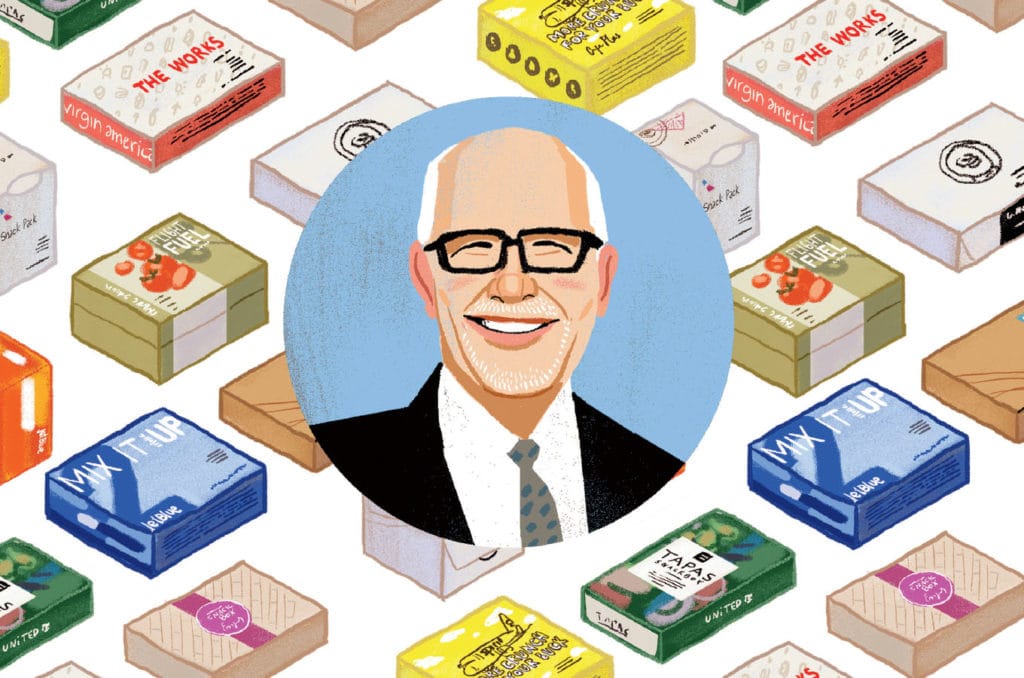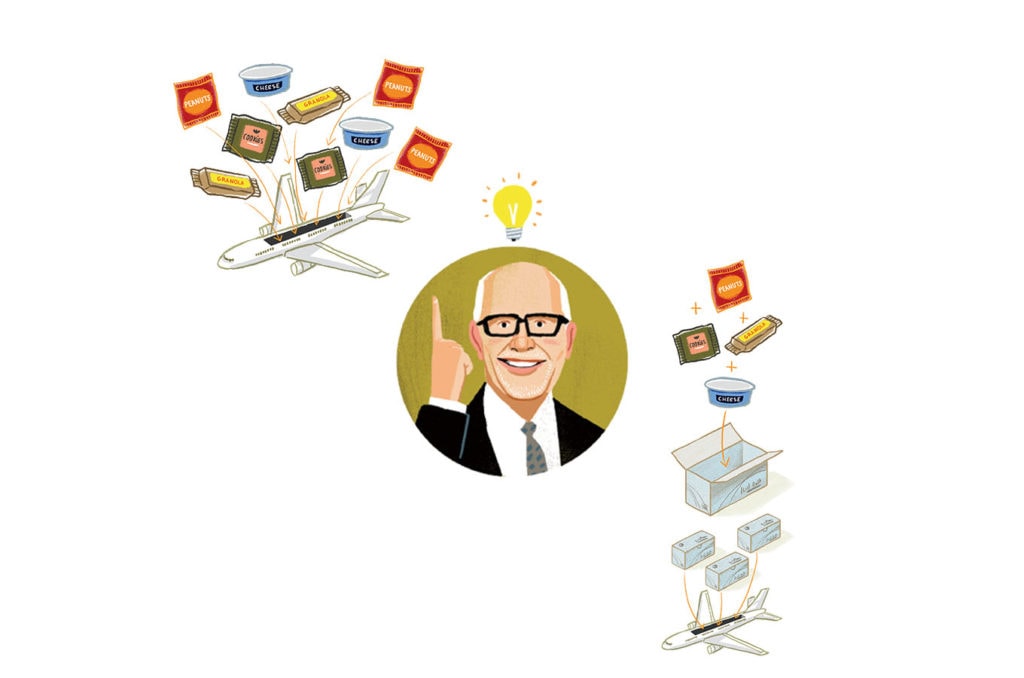Harvey Alpert’s Snack in the Box Idea
Share

APEX Insight: It’s typically the big “out of the box” idea that leads to innovation and success. For Harvey Alpert, CEO of Harvey Alpert and Company (HACO), it was the “snack in the box” idea and seeing a gap that needed to be bridged when the airline industry was going through a monumental change.
Story as told by Harvey Alpert, written by Caroline Ku
There’s a lot that goes into putting food on a tray table that passengers aren’t aware of. They tend to focus on what is served, what it looks like, what it tastes like and, after they’ve eaten their meal, whether or not it left them feeling satisfied. Having been in the airline onboard service business for 50 years, I’ve seen how food and beverage has evolved from full meals in coach class on 90-minute flights to what it is today – a synchronized choreography of suppliers, distributors and caterers pulling off complex logistical feats to accommodate each airline’s unique needs, racing against the clock to deliver on time.
But there was a period when everything was slower. Meals were served seat-side: Lettuce, croutons and dressing were tossed inside a stainless steel bowl in front of the passenger, and flight attendants carved pre-seared sirloin right in the aisle. Now, there are generally no meals served in coach class for domestic US flights, and business- and first-class meals are much less elaborate.
I’ve seen how food and beverage has evolved from full meals in coach class on 90-minute flights to what it is today.
It was word of mouth that led me into this industry. I attended Michigan State University’s hotel and restaurant program knowing I didn’t want to work in hotels or restaurants. Someone told me about Sky Chefs, which was owned by American Airlines at the time, and so I got my feet wet at its Boston operation doing the dirty dishes that came off those flights while training to be a manager. Later, I became an account supervisor for Pan Am, and then a purchasing and storeroom manager for Marriott.
This was in the late 1960s and early ’70s, before Marriott was known for its hotels, when they were opening airline kitchens everywhere. My first assignment with the company was in Chicago where I managed operations during the “graveyard” shift. Then I was transferred to San Francisco, then to Los Angles, and then back to San Francisco. From my San Francisco base I would travel to Seattle, Las Vegas, Albuquerque, Salt Lake City, Phoenix and Guam for a few months at a time, sourcing food and beverage in those places. During that period, I saw a disconnect between what airlines needed for in-flight food and beverage service and what traditional restaurant food and beverage distributors were able to supply. They struggled to deliver the right thing to the right place at the right time. They couldn’t keep up with the flight cycles.
Except Sage Foods, which delivered exclusively to airline catering kitchens. This company understood the whole movement, how to juggle lasagna, Salisbury steak and chicken with rice against the flight cycles. It knew how to keep up with airline demands and ensure passengers didn’t eat the same meal they ate when they flew in as when they flew out.
And so I joined Sage for two years managing its West Coast distribution center. Over time, I got to know many of the brokers and learned they earned commissions based on what was delivered to their assigned geographic area. If a broker representing the northeast sold blueberry muffins to an airline that distributed the goods equally across the northeastern, midwestern, western and southern states, then the commission would be split four ways among each of
the brokers in those territories.

From that I gathered I could be the broker for all of the United States – but exclusively for airlines. I founded Harvey Alpert and Company (HACO) in 1977 under that very premise. HACO now represents more than 20 companies including Coca-Cola, Minute Maid, Mondelez (Nabisco), Pepperidge Farm and King Nut. We offer a range of snacks, beverages and frozen entrées, enough to make a meal and everything in between.
Now airlines compete on airfare, and it is harder to keep amenities such as fresh food on board.
But in 1978, the year after I started HACO, the airline industry took a sharp turn: The Airline Deregulation Act was introduced. Until that point, all airlines charged the exact same fare between Point A and Point B. The only differentiator was the passenger experience: what the cabin looked like, how comfortable the seats were, what liquor or wine was poured and what food was served. Now airlines compete on airfare, and it is harder to keep amenities such as fresh food on board.
Here was the challenge: If there were 90 passengers on a flight, there would be 90 sandwiches, with 90 sets of condiments on 90 trays. If 10 passengers didn’t show up, the airline would throw away 10 servings. And of the 80 passengers, if seven didn’t want a sandwich, well now the airline was throwing away 17 sandwiches. Because a fresh sandwich had to be refrigerated, you had to either use it on the flight or lose it. Needless to say, airlines were “sandwiched” between wanting to serve delicious food on board and the pressure of keeping a lean operation.
I can recall the moment I started Oakfield Farms, the packaged snack business, which makes shelf-stable and frozen snacks, in addition to meal boxes, for both onboard retail and complimentary service in the US and Europe. Continental Airlines had asked me about putting together a sealed, shelf-stable snack to replace its fresh sandwiches. With a non-perishable food item, it wouldn’t matter if only 73 out of the 90 passengers took the snack. Whatever was left could go on the next flight, cutting the waste factor way down.
By 1979, we were producing packaged snacks for American, United, TWA and Hughes Airwest airlines among others. It was a quantum change for HACO.
My packaged snack solution for Continental was a five-by-seven-inch plastic tray that contained crackers, a wedge of cheese, a plastic knife for spreading the cheese, a Ghirardelli chocolate bar, a box of raisins and a napkin. I did a premium version that contained everything above, plus dried fruit and a cookie in a shrink-wrapped berry basket. Both were served in coach. By 1979, we were producing packaged snacks for American, United, TWA and Hughes Airwest airlines among others. It was a quantum change for HACO.
Come next year, it’ll be 40 years since I’ve been in the packaged snack business. In that time, we’ve come up with hundreds of variations of snack boxes: a light bites trio with a fig bar, almonds and gummy bears; a kids’ kit with apple sauce; and an upsized snack box with a protein bar, turkey jerky, roasted chickpeas, Parmesan crisps and coconut toffee. One of the most popular is the tapas box, with olives, salami, hummus and pita chips.
In business, it’s typically the big “out of the box” idea that leads to innovation and success. For me, it was the “snack in the box” idea and seeing a gap in the industry that needed to be bridged when the airline industry was going through a monumental change.
What hasn’t changed since I started in the business is the speed of airplanes and where they fly to – at least for now. LAX is still LAX, and airplanes still fly at 500 mph. There was a brief period of supersonic travel. Now it’s the mission to Mars. Maybe there’s going to be a “Beam me up, Scotty” idea that will involve moving people’s minds without moving people’s bodies. But as far as I’m concerned, all of that is science fiction right now. And no matter how people travel in the future, they will always want something to eat and drink on board.
“Snack in the Box,” was originally published in the 8.1 February/March issue of APEX Experience magazine.


